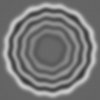While I was cutting out the kawoosh element from the show I was going to use, I realized I'd had a minor oversight; since I decided to just have a free-floating stargate and not the whole SGC gateroom, I wouldn't be able to use the puddle or "foam" from the show, since it was cut off at the bottom where the floor was, and if I wanted to hand-paint complex effects that are occluded by the foreground, I'd be doing 3D post-conversions. So I'd have to use my own puddle.
Here's the test. The kawoosh itself is a white sphere for timing and interactive lighting, I haven't cracked that nut yet, and I don't need to for this specific project.
There are four distinct effects for the stargate event horizon. There's the puddle, which I've already gotten as good as I'm going to get it in all likelihood (experiments with other kinds of procedural textures for the ripples continue to be ever-so-slightly off-the-mark, and nothing's gotten closer than my four layers of "Ripples"), there's the kawoosh, the explosion of water (sort of) when the stargate first opens, a "foam" or "froth" that appears behind the kawoosh and fades into the normal puddle as the kawoosh recedes (and is also used for "flickering" when a stargate connection is unstable), and a flash that's used when the stargate first activates (and in reverse when it turns off).
I extracted the flash from a close-up shot off of a DVD many years ago for my version 2 Stargate. It's a pretty low-res element, but I think the original is, too. I could pull a higher quality version from the same shot in HD nowadays, but I think I'd rather take a whack at doing it procedurally, which would have some benefits (at the very least, I need to tweak the black-point of this one). It appears to be high-contrast footage of some sort of fluid motion, either water draining or filling something, or possibly a quick flash of something burning away. They used this element pretty consistently throughout SG-1 and Atlantis, though for SGU, they switched to a different one that was much more watery and less over-exposed, which I don't care for. It's too even, I like the little acceleration and curly-cues in this version.
The foam also seems to originally have been a photographic element, some kind of agitated bubbles in SG-1 and SGA (SGU used a continuation of their "opening flash" element"), maybe a close-crop of one of their filmed kawoosh elements. I'm pretty happy with the procedural I've gotten for this one, though I might change the shape of the object it's applied to to give it a little "flow" from the center, either a cone or hemisphere that'll be flattened out in the end. Either way, it'll be mostly hidden by the kawoosh proper, along with bloom and lens flare, so it's not that important.
The interactive puddle ripples turned out better than I hoped. I made a simple "ripple" texture in Photoshop and just applied it to the bump map and scaled it over time; I was afraid throwing in an extra node would disrupt the whole balance, but it was fine. It's not perfect, especially when it first starts. In an ideal would I'd like to figure out some way to render out what's intersecting with the puddle as a clip map and have After Effects or something "emit" ripples ripples frame by frame instead of dropping them in manually, but I think I can build on this technique to match what was done on the shows (which was probably accomplished in a similar way, you can usually see when someone walks through there are just three or four spot-ripples quickly expand and merge together into one big irregular ripple).

I spent some time over the weekend experimenting with possible kawoosh techniques. It feels like it should be so simple with modern simulation technology, but I don't want to buy a whole new program, even a relatively inexpensive one, to do one effect, especially if I'm not sure it's going to come out well. I fiddled around with Lightwave's gas solver, but whenever I got anything promising, it tended to fall apart immediately as I adjusted one thing or another. I took another look at
the best fan-made kawoosh I've seen, and I think I've figured out what's going on. It looks like it's just a particle emitter, and, here's the clever part, rather than trying to figure out how to get all the particles to retract back in to the "surface," he just played them being emitted back in reverse. Which is also what they did on the shows, the receding kawoosh is frequently the same footage of it expanding, but backwards.
I've got one more idea I want to try before that, though. Reviewing
the Lightwave OpenVDB intro video, it occurred to me I could try using a series dummy spheres roughly approximating the motion I want, convert them into Level Sets, expand them and have them glomp together into one smooth mass (technical term), then apply some displacement maps a la
Robert Wilde's technique to get it to churn up appropriately, so I get the control of doing it by hand without the weird squishing that comes from animating it with morphs.
EDITED TO ADD:
And, what luck, the last of the Milky Way animation finished (re)rendering today. I threw in the sound effects for this version because it was fun (also, I don't have clean copies for the movie version, and the Atlantis sounds are really wacky and shrill).








